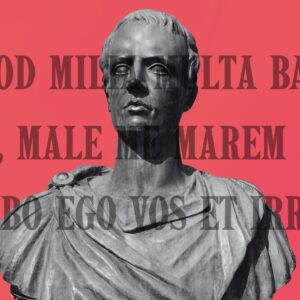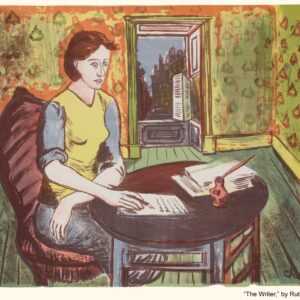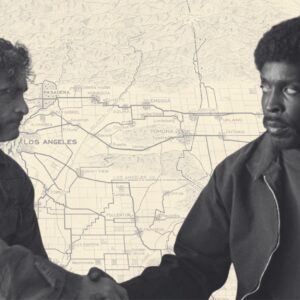
Oedipa Maas: Our Guide to Contemporary Paranoia
The Ongoing Relevance of Pynchon's The Crying of Lot 49, 50 Years Later
A global postal conspiracy. Post horns graffitied across southern California. LSD prescribed as treatment for anxiety. Obscene radio station hosts. Beatles cover bands. Widespread paranoia. The Crying of Lot 49, Thomas Pynchon’s second novel, is quirky and eccentric even by Pynchon’s standards. Now 50 years old, the slim novel is truly a snapshot of mid-1960s culture.
John Ruskin has said “all books are divisible into two classes: the books of the hour and the books of all time.” Yet The Crying of Lot 49 occupies a strange third space: novels that are timely yet timeless—books that are so suffused with the cultural minutia and noise of a moment that their saturation itself helps them to endure.
Far from dated, Pynchon’s novel is worth revisiting half a century after its publication. The book’s main character, Oedipa Maas, is a woman seeking meaning in a confusing world. She begins the novel in a mystically domestic moment, standing “in the living room, stared at by the greenish dead eye of the TV tube, spoke the name of God, tried to feel as drunk as possible.” She has just been named executrix of the estate of her millionaire ex-boyfriend, Pierce Inverarity, who had a penchant for prank phone calls and financing the military-industrial complex.
Oedipa is stirred by this development, but not quite shaken. The key to reading Pynchon is recognizing that a comedian never wishes to be found-out as a satirist; to be found-out is to admit earnestness and intention. Even Eugène Ionesco, Pynchon’s literary uncle, had a purpose to his parody in the bawdy The Bald Soprano—although it took him years to admit the game. Pynchon might throw Oedipa into a world she did not create, but he does so by arming her and disarming the men who surround her.
While Pynchon has been placed firmly into the masculine canon of the previous century, Oedipa is his breakout character: a woman who, against all odds, strives to remake the world into a place of meaning and structure. It is the men in Pynchon’s California who are secondary: they are duplicitous, flighty, and weak. Mucho, Oedipa’s husband, is a pervert disk jockey who could not “use honey to sweeten his coffee for like all things viscous it distressed him.” Roseman, a lawyer-friend, “tried to play footsie with her under the table” but Oedipa “was wearing boots, and couldn’t feel much of anything.” Another lawyer, former child-actor Metzger, wants to play a form of strip poker, so Oedipa drowns herself in clothing: “six pairs of panties in assorted colors, girdle, three pairs of nylons, three brassieres, two pairs stretch slacks, four half-slips, one black sheath, two summer dresses, half dozen A-line skirts, three sweaters, two blouses, quilted wrapper, baby blue peignoir and old Orlon muu-muu.”
There’s depth beneath this silly surface. Early in the novel, Oedipa returns to San Narciso to examine Pierce’s books and records. Pynchon puts her in a rented Impala on a Sunday afternoon, and she pauses like God at the top of a hill. She looks down at the streets and compares them to the circuit of a transistor radio, considering that “there were to both outward patterns a hieroglyphic sense of concealed meaning, of an intent to communicate.” Oedipa is a character who can both become enthralled by “this illusion of speed, freedom, wind in your hair, unreeling landscape”—yet recognize that “it wasn’t.” Rather, this industrial-suburbia road was a “hypodermic needle, inserted somewhere ahead into the vein of a freeway, a vein nourishing the mainliner LA, keeping it happy, coherent, protected from pain, or whatever passes, with a city, for pain.”
Oedipa’s pain is her constant worry that Pierce has manufactured a game for her, that her will has been, quite literally, bent toward his will. This might suggest another clichéd female character manipulated by a man, but the novel is more complicated than that. Readers looking for a dynamic female protagonist will be pleasantly surprised by Pynchon’s treatment of Oedipa: she is neither romanticized nor sexualized; in fact, her sexuality is a source of power. Thrust into the shadow of Tristero, a multinational postal conspiracy, she doesn’t waver. She fights.
At the end of the book, Oedipa tries to sort the noise of her life. She is not sure whether Pierce “encrypted” Tristero into the will so that Oedipa would discover it, or if she had discovered it by accident. Her search is not the vacuity of empty paranoia. Pynchon can get lyric: “For it was now like walking among matrices of a great digital computer, the zeroes and ones twinned above, hanging like balanced mobiles right and left, ahead, think, maybe endless. Behind the hieroglyphic streets there would either be a transcendent meaning, or only the earth.” Oedipa resigns herself to the fact that “there either was some Tristero beyond the appearance of the legacy America, or there was just America and if there was just America then it seemed the only way she could continue, and manage to be at all relevant to it, was as alien, unfurrowed, assumed full circle into some paranoia.” Pynchon offers that both might be possible: Oedipa could be paranoid and prescient.
Whether or not Oedipa discovers conventional meaning at the end of the novel is besides the point. Her character is active, discerning, as much a part of the “game” as the dead man behind the curtain. It would be difficult to draw direct lines between Oedipa Maas and female protagonists who followed her, but Oedipa is a refreshing archetype: the female detective. To be certain, Oedipa struggles in the novel, and fails far more often than she succeeds, but the book is a sequence of her small resurrections. She refuses to give-in to “the man”—or any men, really.
Oedipa is the prototypical woman thrust into a man’s world. Her paranoid yet powerful descendants have reached print and film. We might find elements of Oedipa in Lauren Olamina, the main character of Octavia Butler’s novel The Parable of the Sower. Unlike Oedipa, Lauren is a teenager, and unlike the setting of The Crying of Lot 49, Lauren’s world is quite literally a dystopian anarchy of the near-future. Yet the intersections between her life and Oedipa’s are curious and enticing. Like Oedipa, Lauren begins the novel “gated” by patriarchy. Pynchon employs the Rapunzel story to offer the possibility that Oedipa’s boring domestic life was akin to a tower, and that Pierce was both a means of escape and another level of constraint. Early in The Parable of the Sower, Lauren lives in a gated community with her family. She often evokes “Dad” as “big on privacy.” The “preacher’s daughter,” she is blessed with the curse of “hyperempathy”: “I feel what I see others feeling or what I believe they feel.” She transcends the walls of her home and her community through this displacing of self.
In the entropic world of The Crying of Lot 49, Oedipa seeks to become a “sensitive”: literally, a psychic who can help sort molecules in a Demon Box, and metaphorically, a woman who can sort through the noise of misinformation to discern the true scope of Tristero. Although she fails at the literal application of the concept, her metaphorical pursuit of the truth is quite similar to Lauren’s hyperempathy. In their attempts to locate their selves within fragmented realities, both women must see and experience the worlds through others’ eyes as means of survival.
Violence ultimately shatters the walls of her gated community, and Lauren must enter the world on her own. When the world takes away her centers of meaning, she is forced to place her own meaning upon the world—which includes the creation of Earthseed, a humanistic religion that Pynchon would appreciate: “Some of the faces of her god are biological evolution, chaos theory, relativity theory, the uncertainty principle, and, of course, the second law of thermodynamics.” Pynchonesque entropy through Lauren’s mouth: “God is Change, and in the end, God prevails.”
A less speculative corollary to Oedipa would be Moll Robbins, an investigative journalist in Don DeLillo’s novel Running Dog. Robbins had been following a senator from New York but discovers a more fascinating subject: the rumored existence of a pornographic film made in Hitler’s bunker, starring the dictator. A peddler named Lightborne shows her the film, but her article about it is nixed by blackmailing intelligence agents. Much like Tristero, the pursuit of the Hitler film is more enticing than the film itself. While Robbins is not as shrewd and dynamic as Oedipa, she shares her predecessor’s struggle of living within a world of military-industrial control.
DeLillo has noted “there’s a surge of acquisitiveness in Running Dog which peters out as soon as all of the players get their hands on the object. They seem immediately to lose interest. I think this was a feeling I had about the country in those particular years, in the late 1970s.” Although Robbins fails to expose the film to her magazine audience, she’s made a faint crack to the glass of the system, which is really all that Oedipa is able to accomplish. DeLillo speaks of Robbins in appreciating terms: “Moll Robbins is the weathervane for all the avarice in the book, the maneuverings for power. Her own imperfections may frustrate the reader who is looking for a moral center . . . We can’t position these acts and attitudes around a 19th-century heroine. They float in a particular social and cultural medium. A modern American medium.” While DeLillo says people like Robbins “tend to walk away from their own conspiracies,” Oedipa remains dogged until the end.
In terms of persistence, a better descendent might be Dana Scully from the recently rebooted X-Files. While Scully might be the reasonable check to the earnestness of her partner Fox Mulder, she sometimes feels the pull of paranoia. In the episode “E.B.E.” from the first season of the show, Scully and Mulder have just finished interviewing a truck driver who had a close encounter with a UFO the night before. In what seems like a transition scene at an airport counter, a woman asks Scully to use her pen. Soon after, Scully and Mulder first visit The Lone Gunmen, a trio who would become regulars on the show (one of the three asks Mulder “Is this your skeptical partner?”).
Their conversation includes a discussion of government tracking, which leads into the next scene at the FBI field office. Scully describes The Lone Gunmen as “the most paranoid people I’ve ever met . . . Did you see the way they answered the telephone? They probably think that every call that they get is monitored and they’re followed wherever they go. It’s a form of self-delusion. It makes them think that what they’re doing is important enough that somebody would–” before pausing. Her pen has stopped working, and she unscrews it to find circuitry wrapped around the ink chamber. It is the type of twist that Pynchon would smirk into existence. Scully might experience a hundred similar justifications for paranoia, and yet she remains skeptical. Likewise, Oedipa constantly wavers between a belief that Tristero is external, real, and ominous, versus the possibility that it is all artifice.
In “Wetwired,” Scully goes full Oedipa. After a string of murders, Mulder believes a “video signal somehow [turns] these people’s anxieties into some kind of dementia . . . a virtual reality of their own worst nightmares.” Scully is one such victim. While in a hotel room, she hears a clicking sound on a landline call with Mulder. She snatches the phone jack from the wall and frantically searches the room for a bug, starting a bout of paranoia that ends with her pulling a gun on Mulder and her own mother. Afterward in the hospital, she says “it was just like the world was turned upside-down. Everybody was out to get me.”
In The Crying of Lot 49, everybody is out to get Oedipa, but unlike the men in her world, she doesn’t cower. She barrels headlong into a conspiracy that formed long before she was born, a conspiracy that appears to have taken a particular interest in this suburban housewife from southern California. One theory goes that Oedipa was chosen because her husband is a disk jockey, someone who “transmits” his own form of noise on the radio, and therefore gives Tristero a wide frequency. Yet as the novel progresses, it becomes possible that Oedipa’s will might even transcend that of her mysterious ex-boyfriend; that it is she who has chosen Tristero. Pynchon has created a character who not only seeks but embraces the ambiguity of her world. Even though Oedipa is unable to find the meaning of her life, she does not conclude that life is meaningless.
In our present moment, it is necessary, rather than radical, to be paranoid. Paranoia is now the result of being aware and observant. We are being watched, tracked, traced, and catalogued. Oedipa’s nightmare has become our reality. Therefore, 50 years later, we should allow her to become our guide.
Nick Ripatrazone
Nick Ripatrazone is the culture editor at Image Journal, a contributing editor at The Millions, and a columnist at Lit Hub. He has written for Rolling Stone, GQ, The Atlantic, The Paris Review, and Esquire. He lives in Andover Township, New Jersey, with his wife and twin daughters. His latest book, Longing for an Absent God, is available from Fortress Press.


















